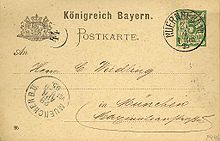
A postcard or post card is a piece of thick paper or thin cardboard, typically rectangular, intended for writing and mailing without an envelope. Non-rectangular shapes may also be used but are rare.

A piece of postal stationery is a stationery item, such as a stamped envelope, letter sheet, postal card, lettercard, aerogram or wrapper, with an imprinted stamp or inscription indicating that a specific rate of postage or related service has been prepaid. It does not, however, include any postcard without a pre-printed stamp, and it is different from freepost for preprinted cards issued by businesses. In general, postal stationery is handled similarly to postage stamps; sold from post offices either at the face value of the printed postage or, more likely, with a surcharge to cover the additional cost of the stationery. It can take the form of an official mail issue produced only for the use of government departments.
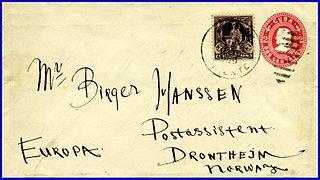
A stamped envelope or postal stationery envelope (PSE) is an envelope with a printed or embossed indicium indicating the prepayment of postage. It is a form of postal stationery.
"French Colonies" is the name used by philatelists to refer to the postage stamps issued by France for use in the parts of the French colonial empire that did not have stamps of their own. These were in use from 1859 to 1906, and from 1943 to 1945.
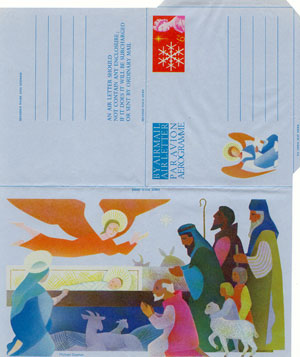
An aerogram, aerogramme, aérogramme, air letter or airletter is a thin lightweight piece of foldable and gummed paper for writing a letter for transit via airmail, in which the letter and envelope are one and the same. Most postal administrations forbid enclosures in these light letters, which are usually sent abroad at a preferential rate. Printed warnings existed to say that an enclosure would cause the mail to go at the higher letter rate.

A greeting card is a piece of card stock, usually with an illustration or photo, made of high quality paper featuring an expression of friendship or other sentiment. Although greeting cards are usually given on special occasions such as birthdays, Christmas or other holidays, such as Halloween, they are also sent to convey thanks or express other feelings.

This is a survey of the postage stamps and postal history of Cuba.
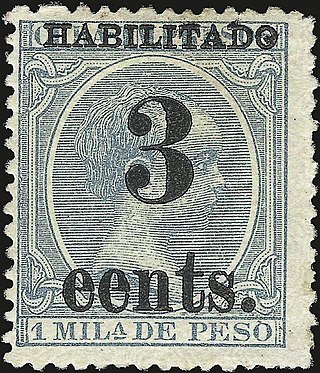
Linn's World Stamp Almanac defines a provisional stamp as "a postage stamp issued for temporary use to meet postal demands until new or regular stocks of stamps can be obtained."

Plating refers to the reconstruction of a pane or "sheet" of postage stamps printed from a single plate by using individual stamps and overlapping strips and blocks of stamps. Likewise, if a sheet 10 or 20 postal cards is typeset, the variations of the letters or design elements may allow reconstruction or plating of the sheets based on these differences.

In philately, an imprinted stamp is a stamp printed onto a piece of postal stationery such as a stamped envelope, postal card, letter sheet, letter card, aerogram or wrapper. The printing may be flat upon the surface of the paper, or embossed with a raised relief. An imprinted stamp is also known as unadhesive stamp or indicium.

In philately, a lettercard or letter card is a postal stationery item consisting of a folded card with a prepaid imprinted stamp. That it is folded over gives the writer twice as much room for the message compared with a postal card. The message is written on the inside and the card is then folded and sealed around the edges. The recipient tears off and discards the perforated selvages to open the card.
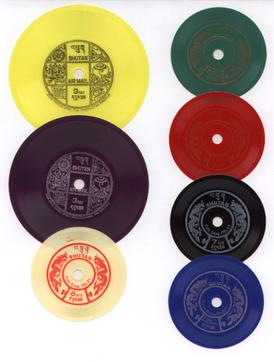
The first postage stamps of Bhutan were issued in 1962, the same year that the first motorable road was opened. Before that there was a mail delivery system in place for official mail using mail runners, and between 1955 and 1962 revenue stamps were accepted as payment for internal mail. With the opening up of Bhutan in the early 1960s, a formal postal system was introduced.
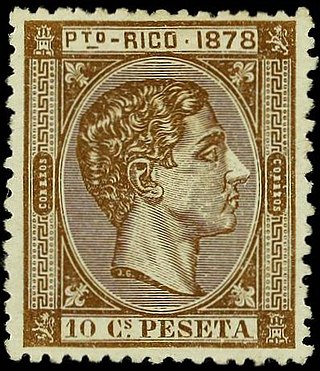
The postal history of Puerto Rico began around 1518, at least for official mail, when Spain adopted general postal regulations; although the first documentation of Spanish postal regulations specific to the Caribbean was 1794. The first postage stamps were issued 168 years ago for Puerto Rico and Cuba in 1856. Postage stamps just for Puerto Rico followed, and later postal cards and telegraph stamps were issued. United States postal administration began in 1899 and the last stamps specifically for Puerto Rico were issued in 1900. They were superseded by U.S. stamps, which are still used today on the island as it remains a territory serviced by the United States Postal Service (USPS).
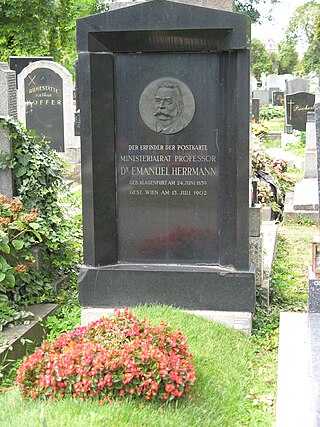
Emanuel Alexander Herrmann was an Austrian national economist. He is considered the decisive last in an international line of inventors of the postal card.
Knife is the cutting die for envelope or wrapper blanks. It is called a knife rather than a die because the latter is an object that makes an embossed printed impression of the stamp or indicium on the envelope. Traditionally, a knife would normally be made of forged steel. It was placed on a stack of paper with the sharp edge against the paper. The press head forced the cutting edge all the way through the stack of paper. The cut blanks were removed from the knife and the process repeated. Not only could it cut out the odd shape of an envelope, but a knife could be used to cut out shapes of airmail stickers or gummed labels in the shape of stars or circles. The variety of shapes a knife could cut would be infinite.

In philately a wrapper is a form of postal stationery which pays the cost of the delivery of a newspaper or a periodical. The wrapper is a sheet of paper, large enough to wrap around a folded or rolled newspaper and with an imprinted stamp to pay the cost of postage. Some catalogs and reference books refer to a wrapper as postal bands which comes from the French term bandes postale. Still others refer to it as a newspaper wrapper or periodical wrapper.

The term corner card means the wording, sometimes with a pictorial feature, in the upper left hand corner of a postal stationery envelope or an envelope designed to have regular adhesive stamps affixed to it. It is there for the purpose of stating the sender's return address to facilitate the return of undeliverable mail.
The United Postal Stationery Society (UPSS) was formed July 1, 1945 from the merger of the Postal Card Society of America, in existence since 1891, and the International Postal Stationery Society, founded 1939. Current membership stands at about 1,000. The organization's journal since 1949 is called Postal Stationery. Articles appear about new issues of U.S. and international postal stationery, plus articles on rare and unusual stationery.

The term earliest reported postmark or ERP is a term used by the United Postal Stationery Society (UPSS) for the past four or more decades. They have established a database in which the earliest postmarks on stamped envelopes or postal card or letter sheets is kept. Postmarks are typically dated from days to many months after the date of issuance. An envelope can come out in varying sizes, colors, or shapes without notification to the public. Collecting the earliest reported postmark for a particular variety is an ongoing effort.


